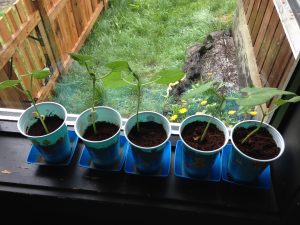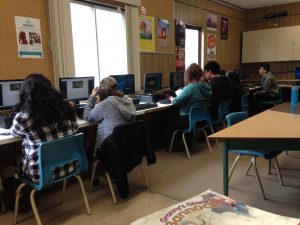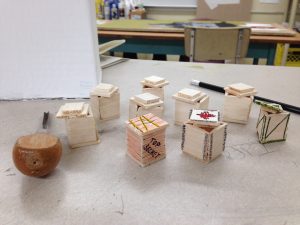I began my second week in Kyuquot with the question I had asked myself by the end of my first week: How do rural environments shape learning? This is, of course, a question that is too large and too complex to adequately address in a short blog post, but I hope that my reflections will touch on some key points.
Kyuquot Elementary Secondary School has four student cohorts: primary,  intermediate, junior, and senior. This structure is due to the small student population, which demands the organization of students into single classes of multiple grades. As suspected, this creates significant challenges to teachers in their planning and instruction. But I was curious as to how the local preschool/kindergarten approached instruction. After receiving the consent of my CFE contact, I spent Wednesday assisting the preschool and kindergarten teachers at the Houpsitas Preschool and Kindergarten. H.P.K. is owned and managed by the Nation, whereas K.E.S.S., rests on a sliver of Crown land. I myself had not been in a preschool since I was four years old, so it was both informative and a treat to experience the young ones’ enthusiasm for learning, as well as the teachers’ pedagogical approach to early years education. I spoke with the preschool teacher – a young man – about the school’s approach to learning and he informed me that this was their first year of running the school and they were continuing the routines established by the previous educators that worked there. But he also told me that changes were probable in the following school year, which left me feeling optimistic that rural school districts were receiving new teachers with a great enthusiasm to incorporate the new curriculum into their praxis. My day at Houpsitas was spent singing, dancing, playing language and literacy games, and learning about the life cycle of bean plants. I was told by an instructor during my first term of the UBC teacher education program that junior and senior secondary students are forgetting how to play, because their teachers are forgetting how to play. Spending a day at Houpsitas reminded me of the importance of embedding play into how I learn and how I expect my students to learn.
intermediate, junior, and senior. This structure is due to the small student population, which demands the organization of students into single classes of multiple grades. As suspected, this creates significant challenges to teachers in their planning and instruction. But I was curious as to how the local preschool/kindergarten approached instruction. After receiving the consent of my CFE contact, I spent Wednesday assisting the preschool and kindergarten teachers at the Houpsitas Preschool and Kindergarten. H.P.K. is owned and managed by the Nation, whereas K.E.S.S., rests on a sliver of Crown land. I myself had not been in a preschool since I was four years old, so it was both informative and a treat to experience the young ones’ enthusiasm for learning, as well as the teachers’ pedagogical approach to early years education. I spoke with the preschool teacher – a young man – about the school’s approach to learning and he informed me that this was their first year of running the school and they were continuing the routines established by the previous educators that worked there. But he also told me that changes were probable in the following school year, which left me feeling optimistic that rural school districts were receiving new teachers with a great enthusiasm to incorporate the new curriculum into their praxis. My day at Houpsitas was spent singing, dancing, playing language and literacy games, and learning about the life cycle of bean plants. I was told by an instructor during my first term of the UBC teacher education program that junior and senior secondary students are forgetting how to play, because their teachers are forgetting how to play. Spending a day at Houpsitas reminded me of the importance of embedding play into how I learn and how I expect my students to learn.
 One of my goals during this CFE is to examine the relationship between technology and learning in rural school districts. Put in other words, what is the impact of employing a variety of technologies in a rural learning environment? I found this question to be essential in understanding how teachers are to provide their students with the tools they will need to develop necessary 21st century skills. I found this issue to be especially relevant to teachers working with First Nations communities, many of which are rural. Technology, in all its forms, has the potential to empower teachers to teach new modes of literacy to their students, making it easier to reach out to vulnerable populations. To draw on a specific example from my CFE, I found that my “Over the top!” online activity worked exceptionally well in engaging our senior students in historical perspective taking. The activity has students assume the role of a WWI infantry soldier in a choose-your-own-adventure game. It was this approach of learning through play, as well as the prospect of doing an activity outside of class, that peaked their interest. In addition to their play-through, students were expected to fill out critical question sheets that had them reflecting on their experience of the game through drawings, significant vocabulary, question posing, and a written summary. Overall, the activity was a success and the humanities teacher thanked me for my contribution to the class.
One of my goals during this CFE is to examine the relationship between technology and learning in rural school districts. Put in other words, what is the impact of employing a variety of technologies in a rural learning environment? I found this question to be essential in understanding how teachers are to provide their students with the tools they will need to develop necessary 21st century skills. I found this issue to be especially relevant to teachers working with First Nations communities, many of which are rural. Technology, in all its forms, has the potential to empower teachers to teach new modes of literacy to their students, making it easier to reach out to vulnerable populations. To draw on a specific example from my CFE, I found that my “Over the top!” online activity worked exceptionally well in engaging our senior students in historical perspective taking. The activity has students assume the role of a WWI infantry soldier in a choose-your-own-adventure game. It was this approach of learning through play, as well as the prospect of doing an activity outside of class, that peaked their interest. In addition to their play-through, students were expected to fill out critical question sheets that had them reflecting on their experience of the game through drawings, significant vocabulary, question posing, and a written summary. Overall, the activity was a success and the humanities teacher thanked me for my contribution to the class.
 The major event of this week was a parent-teacher meeting on student misbehaviour amongst the junior and senior secondary cohorts. One of the concerns raised during the meeting, was the issue of teacher retention. It was clearly visible that parents were concerned regarding this matter and that the district’s inability to convince teachers to stay was detrimental to K.E.S.S.’s ability to strengthen the relationship between the school community and the village. Other issues raised during the meeting were responsible use of technology in class, student attendance, and the creation of a PAC. Parents also acknowledged that a lot of the behavioural issues arise in the home and need to be addressed at their source. At certain points the meeting became emotional with parents pleading for the protection of the future of those students who were serious about their learning. They felt the current system favoured managing those students who did not wish to learn in class and neglecting those who wanted to learn. In the end, the outcome of the meeting was both positive and productive. A new, clear protocol of dealing with misbehaviour was established: the teacher would count down from 5 to 0, prompting students on both their positive and negative behaviours (ex. “I am looking for good listening skills”). Those students reluctant to comply with teacher direction would have their name recorded on the board, which could at a later point be removed for correct behaviour. If the misbehaviour gets worse, then the student will be informed that they are to serve a detention. If this detention is ignored, then the student would be suspended until they return to the school with a parent, who would then sit down with the teacher and principal to discuss a reason and solution to the misbehaviour. Most interesting to me, was the suggestion that the young adult men of the village should visit the school and act as volunteers to model good citizenship to the junior and senior students (in all cases of misbehaviour, boys were the actors). A great many ideas were discussed at this meeting and it was a most inspiring and emotional experience.
The major event of this week was a parent-teacher meeting on student misbehaviour amongst the junior and senior secondary cohorts. One of the concerns raised during the meeting, was the issue of teacher retention. It was clearly visible that parents were concerned regarding this matter and that the district’s inability to convince teachers to stay was detrimental to K.E.S.S.’s ability to strengthen the relationship between the school community and the village. Other issues raised during the meeting were responsible use of technology in class, student attendance, and the creation of a PAC. Parents also acknowledged that a lot of the behavioural issues arise in the home and need to be addressed at their source. At certain points the meeting became emotional with parents pleading for the protection of the future of those students who were serious about their learning. They felt the current system favoured managing those students who did not wish to learn in class and neglecting those who wanted to learn. In the end, the outcome of the meeting was both positive and productive. A new, clear protocol of dealing with misbehaviour was established: the teacher would count down from 5 to 0, prompting students on both their positive and negative behaviours (ex. “I am looking for good listening skills”). Those students reluctant to comply with teacher direction would have their name recorded on the board, which could at a later point be removed for correct behaviour. If the misbehaviour gets worse, then the student will be informed that they are to serve a detention. If this detention is ignored, then the student would be suspended until they return to the school with a parent, who would then sit down with the teacher and principal to discuss a reason and solution to the misbehaviour. Most interesting to me, was the suggestion that the young adult men of the village should visit the school and act as volunteers to model good citizenship to the junior and senior students (in all cases of misbehaviour, boys were the actors). A great many ideas were discussed at this meeting and it was a most inspiring and emotional experience.
School district 84 has a policy of shorter school weeks on a fortnightly basis. Therefore, schools throughout the district are organized between week one and week two with week two ending on Thursdays. This week was shorter and so many of the teachers left Kyuquot to visit family and friends for the weekend. During our orientation to the CFE, the district superintendent informed us that this initiative was created to improve teacher retention and that it has seen success.
Next week, the primary and intermediate cohorts will be leaving to Bella Bella for a potlatch. The junior and senior art classes have been busy carving bentwood boxes as gifts for Kyuquot students to present there. You can see some of their progress below.

Until next time,
Alex M.